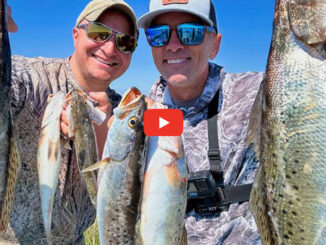
The fishing in Delacroix this time of year can be really good, but the speckled trout patterns shift with the ever-changing weather. Thirty degree temperature swings are not uncommon and Delacroix fishing guide Capt. Lane Zimmer knows paying attention to weather is crucial for success this month.
“We’re hoping that we get some colder weather for February where these fish actually transition into their winter spots — Twin Pipeline, False River, Oak River,” he said. “All those deeper holes should hold trout if the weather cools off.”
Focus on bayou bends
When fishing these areas, Zimmer often fishes in the bayous around these places.
“I’ll try to focus on deeper bends in the main bayous — something where if there’s any amount of shrimp or minnows in there, they’ll get funneled through there,” he said. “The fish are going to be cold and lazy, so they’ll set up to where it’s easiest for them to feed and not have to move too much.”
In those deeper bayous, Zimmer ties on 3/8 and ½-ounce Deathgrip jig-heads, teamed with chartreuse Mad Mullets if the water is dirty. If the water is clean, Zimmer opts for a different color scheme.
“If we have decently clean water when it’s cold, I like to focus on something with some purple in it,” he said.
Zimmer has a strong preference for the Fat Tuesday color of Mad Mullet and Ghost Minnow in clean, winter water.
When fishing the deeper areas, Zimmer suggested trying all depths in the bayou.
“They might be dead on the bottom or up on the ledge,” he said. “That’s just something you’re going to have to figure out.”
Lakes can pay off
On the warmer weather days, Zimmer has an entirely different approach.
“If it stays mild, then you will still catch fish in places like Round Lake, Four Horse Lake, Lake John — stuff like that that has some shallower water with access to deep water,” he said.
When fishing these major lakes, Zimmer likes to fish with a 1/8-ounce or ¼-ounce Deathgrip jighead tightlined. However, he also said a popping cork can be effective.
“If we do go to a cork, it’s not going to be a very aggressive pop like we do in the summer time,” Zimmer said.
Leader length under the cork is also very important, according to Zimmer.
“In the wintertime, I’ll set my leaders a little bit deeper — around 3 feet — just because I want that bait to hang closer to the bottom for those cold, lazy trout so they don’t have to move as far,” he said.
Many anglers use ¼-ounce jigheads underneath corks, but Zimmer feels like they could be hurting the number of bites they get by doing so.
“Everything is going to be moving slow in the wintertime — baitfish and shrimp included — just because the water is cold,” he said. “I don’t want that bait moving fast if the water is cold. It just looks a lot more natural when that bait falls with a 1/16-ounce jighead compared to a heavier jighead.”


